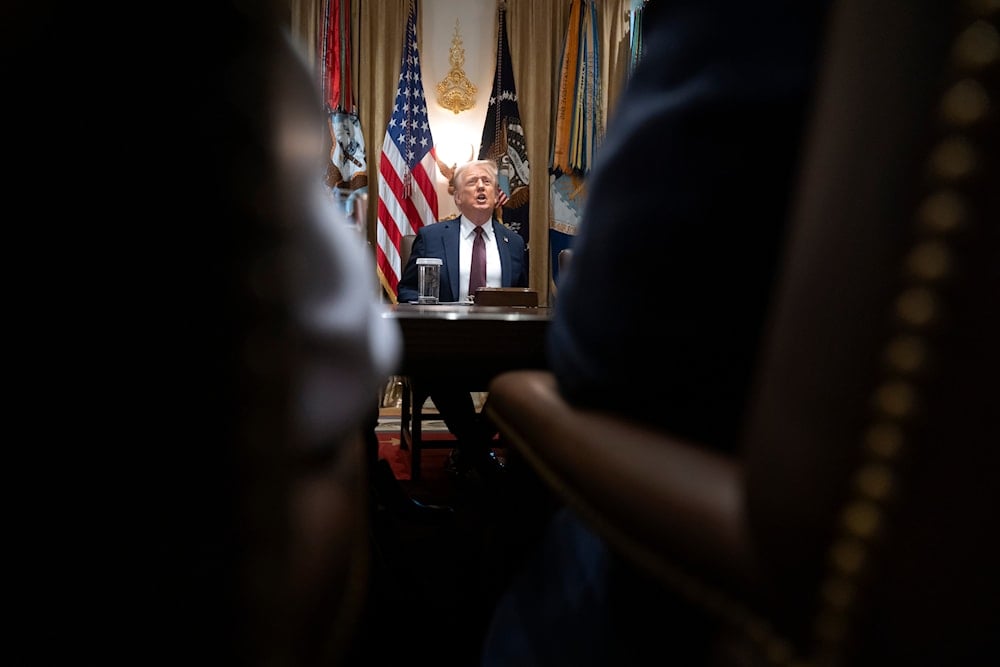US Court rules Trump's tariffs are mostly illegal
A divided US appeals court ruled that most of Donald Trump’s tariffs are illegal, sparking a legal showdown that could send Trump’s trade policy to the Supreme Court.
-

US President Donald Trump speaks during a cabinet meeting at the White House on August 26, 2025, in Washington. (AP Photo/Mark Schiefelbein)
A divided US Court of Appeals for the Federal Circuit ruled on Friday that most of Donald Trump’s tariffs are illegal, dealing a major blow to a central pillar of his economic and trade agenda. The court allowed the tariffs to remain in place until October 14, giving the Trump administration time to file an appeal before the Supreme Court.
The 7-4 decision from the US Court of Appeals in Washington, DC, concluded that the International Emergency Economic Powers Act (IEEPA) does not grant presidents the authority to impose tariffs. Six Democratic-appointed judges formed the majority, while two Republican-appointed judges dissented.
The ruling addressed two sets of levies: Trump’s so-called “reciprocal” tariffs imposed in April and additional tariffs in February against China, Canada, and Mexico. The court clarified that other tariffs, such as those on steel and aluminum imports, remain unaffected.
Trump had justified both sets of tariffs under IEEPA, a 1977 law typically used to impose sanctions or freeze assets during national emergencies. The court stated that while the statute gives presidents significant powers, it does not explicitly authorize tariffs or taxation.
“The statute bestows significant authority on the President … but none of these actions explicitly include the power to impose tariffs, duties, or the like, or the power to tax,” the ruling noted.
The Trump administration argued that IEEPA’s emergency provisions allow tariffs as part of regulating or blocking imports. Trump had declared a national emergency in April, citing trade imbalances and the cross-border flow of drugs, and argued that tariffs on China, Canada, and Mexico were necessary to curb fentanyl trafficking, an accusation those governments deny.
Trump’s response and political implications
Trump criticized the ruling, calling the appeals court “highly partisan.” In a post on Truth Social, he warned, “If these Tariffs ever went away, it would be a total disaster for the Country," expressing confidence that the Supreme Court would reverse the decision and uphold what he described as vital measures for US trade policy.
The tariffs have been a central tool in Trump’s foreign and economic policy, enabling his administration to renegotiate trade agreements and exert pressure on trading partners. However, they have also increased uncertainty in financial markets.
The market reaction to the ruling was muted, although analysts cautioned that prolonged legal disputes over US trade policy could add further volatility. “The last thing the market or corporate America needs is more uncertainty on trade,” said Art Hogan, chief market strategist at B. Riley Wealth.
William Reinsch, a former Commerce Department official, noted the Trump administration had been expecting this decision: “It’s common knowledge the administration has been anticipating this outcome and is preparing a Plan B, presumably to keep the tariffs in place via other statutes.”
Next steps: Toward a Supreme Court showdown
The ruling sets the stage for a potential Supreme Court case involving the Trump tariffs. The Court, with its 6-3 conservative majority, has in recent years limited expansive interpretations of old laws while also issuing rulings favorable to Trump’s second-term agenda.
At least eight lawsuits have challenged Trump’s use of IEEPA for tariffs, including cases brought by small businesses and Democratic-led states. The US Court of International Trade previously ruled against the measures in May, concluding that Trump had exceeded his authority.
The broader legal fight could determine not only the future of Trump’s tariffs but also the limits of presidential power in shaping US trade policy. Analysts warn that the outcome may also impact Trump’s broader economic agenda, which includes ongoing disputes over the independence of the Federal Reserve.

 4 Min Read
4 Min Read








